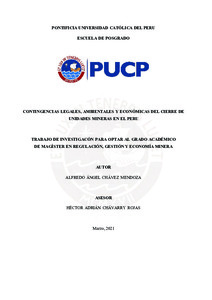Contingencias legales, ambientales y económicas del cierre de unidades mineras en el Perú
Abstract
Estamos en el año 2021 y transcurridos más de quince años de la regulación de los Planes de
Cierre de Minas, ya se encuentran en cierre final algunas unidades mineras y se van presentando
situaciones que ponen a prueba el marco regulatorio, como el abandono de operaciones sin
cumplir con el cierre de minas, la ejecución de las cartas fianzas que resultan insuficientes para
financiar el cierre, la ausencia de normas que definan a las autoridades que acciones deben
seguir para realizar el cierre de minas o la postergación de cierre de las minas o las
transferencias de minas próximas al cierre, lo que genera incertidumbre sobre si la existencia
de los planes de cierre y las garantías financieras constituidas en favor del Ministerio de Energía
y Minas son eficientes para evitar dichas contingencias.
La presente investigación hace una revisión del marco legal existente a nivel nacional e
internacional de algunos países mineros, respecto de cómo se regulan los cierres de minas, en
especial enfocado en los instrumentos económicos previstos en sus ordenamientos y que riesgos
existen en nuestro marco legal vigente a efectos de proponer alternativas regulatorias que
busquen minimizar los riesgos legales, ambientales y económicos asociados ante el
incumplimiento del cierre de minas.
Como parte del estudio además revisaremos 4 casos de unidades mineras que buscan mostrar
los diversos problemas advertidos en el cierre de minas y así poder proponer soluciones a los
riesgos advertidos. Estas propuestas incluyen nuevos mecanismos económicos a los vigentes
que permitan asegurar que los privados puedan contar con los recursos suficientes para financiar
el cierre de minas o que el Estado los pueda realizar en especial en el caso de tratamiento de
aguas permanentes.
Generalmente se visualiza al cierre de minas como actividades futuras lo que impide detectar
las inconsistencias o vacíos de la regulación en la actualidad.
El propósito principal de la investigación es llamar la atención sobre las posibles contingencias
que se pudiesen presentar (y que se están presentando) en la ejecución de los planes de cierres
de minas en el Perú a efecto que las autoridades y la industria puedan modificar de manera
oportuna las normas vigentes y evitar que la responsabilidad del cierre efectivo de minas se
traslade al Estado y se terminen externalizando los impactos ambientales y costos económicos
a la sociedad de proyectos de inversión privados. We are in the year 2021 and after more than fifteen years of the regulation of the Mine Closure
Plans, some mining units are already in final closure and situations that put the regulatory
framework to the test, such as the abandonment of operations without comply with the closure
of mines, the execution of letters of guarantee that are insufficient to finance the closure, the
absence of regulations that define the authorities what actions they must follow to carry out the
closure of mines or the postponement of closure of mines or transfers of mines close to closure,
which generates uncertainty as to whether the existence of closure plans and financial
guarantees established in favor of the Ministry of Energy and Mines are efficient to avoid such
contingencies.
This research makes a review of the existing legal framework at the national and international
level of some mining countries, regarding how mine closures are regulated, especially focused
on the economic instruments provided for in their regulations and what risks exist in our current
legal framework in order to propose regulatory alternatives that seek to minimize the legal,
environmental and economic risks associated with non-compliance with the closure of mines.
As part of the study, we will also review 4 cases of mining units that seek to show the various
problems noted in the closure of mines and thus be able to propose solutions to the risks noted.
These proposals include new economic mechanisms to those in force to ensure that private
companies can have sufficient resources to finance the closure of mines or that the State can
carry them out, especially in the case of permanent water treatment.
Generally, the closure of mines is viewed as future activities, which prevents the detection of
inconsistencies or gaps in current regulation.
The main purpose of the investigation is to draw attention to the possible contingencies that
may arise (and are occurring) in the execution of mine closure plans in Peru so that the
authorities and the industry can modify in a way the current regulations are timely and avoid
that responsibility for the effective closure of mines is transferred to the State and the
environmental impacts and economic costs of private investment projects end up being
outsourced to society.
Temas
Industria minera--Aspectos ambientales--Perú
Política minera--Perú
Minas--Clausura
Industria minera--Legislación--Perú
Política minera--Perú
Minas--Clausura
Industria minera--Legislación--Perú
Para optar el título de
Magíster en Regulación, Gestión y Economía Minera
Collections
The following license files are associated with this item:






